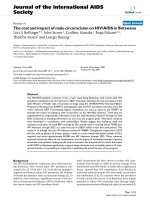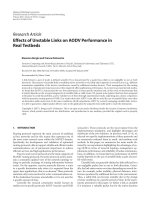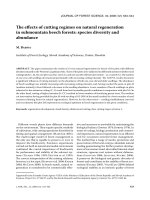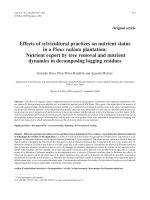CYP2C19 polymorphisms and effects of polymorphic CYP2C19 on clopidogrel response in Vietnamese stroke patients
Bạn đang xem bản rút gọn của tài liệu. Xem và tải ngay bản đầy đủ của tài liệu tại đây (118.22 KB, 7 trang )
Journal of military pharmaco-medicine no6-2019
CYP2C19 POLYMORPHISMS AND EFFECTS OF POLYMORPHIC
CYP2C19 ON CLOPIDOGREL RESPONSE IN
VIETNAMESE STROKE PATIENTS
Do Duc Thuan1; Pham Dinh Dai1; Tran Van Khoa2
SUMMARY
Objectives: To research CYP2C19 polymorphism and effects of CYP2C19 polymorphisms
on clopidogrel response in ischemic stroke patients. Subjects and methods: A prospective and
cross-sectional analysis was implemented among stroke patients in a 103 Military Hospital, from
the beginning of 2017 to August 2018. 144 patients with cerebral infarction were given
clopidogrel at 75 mg daily and platelet aggregation was measured using light transmittance
aggregometry with adenosine diphosphate 5 µg/L after 7 days. Clopidogrel resistance was
controlled until it got more than 50%, and identification of polymorphisms by Sanger
sequencing. Results: Frequency of patients carrying at least one allele CYP2C19*1 was
59.72%, at least one allele CYP2C19*2 was 92.36% and at least one allele CYP2C19*3 was
43.75%. Frequency of poor metabolizer of clopidogrel was 40.29%. Clopidogrel resistance in
the CYP2C19*1/*1, CYP2C19*1/*2 plus CYP2C19*1/*3 genotypes was 45.83%. In the same
manner, the frequency of CYP2C19*2/*3 genotype was 54.17%. Conclusion: Ischemic stroke
patients with the CYP2C19*2,*3 alleles had a higher incidence and were also a contributing
factor in increasing the resistance to clopidogrel.
* Keywords: Stroke; CYP2C19 gene; Polymorphism; Clopidogrel.
INTRODUCTION
Clopidogrel (methyl [+]-[S]-a-[2chlorophenyl]-6.7-dihydrothieno
[3,2-c]
pyridine-5 [4H]-acetate hydrogen sulfate)
is an oral thienopyridine derivation.
Clopidogrel, a kind of pro-drug, after
absorption in gastrointestinal tract, is
metabolized in liver by CYP2C19 enzyme.
This is an isoenzyme of cytochrome P450
[5]. Benefits of clopidogrel have been
widely recognized in treatment and
prevention of ischemic stroke but some
patients still face recurrent ischemic
stroke although they are being treated
with clopidogrel [10]. One reason is
polymorphism of the CYP2C19 gene [5].
In Asia, the CYP2C19* 2,*3 allele genotypes
account for a high proportion and these
genotypes do not support metabolism of
clopidogrel, resulting in poor efficacy of
clopidogrel in treatment and prophylaxis
happens within ischemic stroke patients
when there are thrombotic events [7].
1. 103 Military Hospital
2. Vietnam Military Medical University
Corresponding author: Do Duc Thuan ()
Date received: 19/06/2019
Date accepted: 05/08/2019
140
Journal of military pharmaco-medicine no6-2019
In Vietnam, clopidogrel has been widely
prescribed in treatment of ischemic stroke
[1, 3]. In order to improve the clinical
efficacy of clopidogrel, this research takes
a Look on CYP2C19 polymorphism and
its impacts on clopidogrel response in
patients with cerebral infarction.
SUBJECTS AND METHODS
1. Subjects.
144 consecutive patients were treated
at Stroke Department, 103 Militayr Hospital
from Jun 2017 to March 2018.
* Inclusion criteria: Patients were
diagnosed by definition stroke of WHO in
1989 [11] and confirmed by 1.5 Tesla
brain magnetic resonance imaging or 8
layers computed tomography. All patients
were treated with clopidogrel 75 mg once
daily (Sanofi Company Ltd) for at least 7
days. The treatment regimen was unchanged
during the study in each patient. Protective
neuron medication was the same in the all
patients: Cerebrolysin 20 mL IV, piracetam
8 g IV, choline alfoscerate 2 g IM.
* Exclusion criteria: Allergy to clopidogrel;
using anticoagulation or other antiplatelet
drugs in the preceding 2 weeks or during
the study period; patients with acute ischemic
stroke were treated with IV alteplase;
patients with carotid endarterectomy or
carotid angioplasty and stenting; patients
who were severe water and electrolyte
disorder or decreased level of consciousness,
infarction > 1/3 MCA territory on MRI or
CT-scan, hemorrhagic image on MRI or
CT-scan, hemoglobin < 80 g/L or > 160 g/L,
platelet count < 100,000/L or > 450,000/L;
patients who had the following diseases:
myocardial infarction, atrial fibrillation,
heart failure level 3 or 4 (New York Heart
Association), infective endocarditis, heart
valve surgery, congenial heart disease,
hepatitis, cirrhosis, liver cancer, estimated
glomerular filtration rate (eGFR)
< 30 (mL/min/1.73 m2) or they were being
on a kidney machine and other severe
diseases and patients refused to participate
in the study were also uninvolved in this
study.
2. Methods.
- Methods: A prospective, cross-sectional
analysis at the Department of Stroke,
103 Military Hospital from June 2017 to
March 2018.
- Platelet aggression assay: Using light
transmission aggregometry (LTA) with
adenosine5′-diphosphate (ADP) 5 µg/L.
Patients abstained ≥ 8 hours before blood
samples were collected. Blood samples
were drawn into vacutainer tubes containing
0.5 mL of 3.2% sodium citrate (BectonDickinson,SanJose, CA), preserved at
18 - 250C and processed in 60 mins by
a Chrono-Log 530 of American at
Hematology Department, 103 Military
Hospital.
Clopidogrel resistance definition:
Clopidogrel resistance was defined as
platelet aggregation > 50%. ADP5 µg/Linduced platelet aggression assay was
performed by LTA at one point: treated
with clopidogrel 75 mg once daily for at
least 7 days [6].
- CYP2C19 polymorphism assay: DNA
was extracted from peripheral blood
(anticoagulated EDTA) by DNA blood mini
kit (Qiagen, Germany). Amplification PCR
on Mastercycle ProS (Eppendorf, Germany)
using specific primers from IDT-American
141
Journal of military pharmaco-medicine no6-2019
Company. Temperature cycle: 95oC x 1 min
[94oC x 1 min, 57oC x 1 min (*2) or 56oC x
1 min (*3), 72 x 1 min] x 35 cycles, 72oC x
20 mins, stop at 4oC electrophoresis
testing PCR products. Good product with
electrophoresis is light, clear and only one
168 bp band for (*2), 270 bp band for (*3).
CYP2C19 polymorphisms (CYP2C19*2 and
CYP2C19*3) were determined by Sanger
sequencing using Big Dye Terminator
v3.1 cycle sequencing kit. All analyses
were performed by using BioEdit software
at Department of Biology and Medical
Genetics, Military Medical University.
RESULTS AND DISCUSSION
1. Patient population.
P2C19 gene assay was performed in 150 patients, but 6 patients were excluded
because of lack of research criteria.
Table 1: Demographic, baseline clinical and procedural characteristics of the patients.
*1/*1
(n = 6)
*1/*2, *1/*3
(n = 80)
*2/*3
(n = 58)
Total
(n = 144)
p value
71.33 ± 7.20
67.35 ± 11.17
68.10 ± 10.96
67.82 ± 10.92
> 0.05
Male (%, n)
71.43 (5)
56.25 (45)
53.45 (31)
55.86 (81)
> 0.05
Diabetes mellitus (%, n)
33.33 (2)
26.25 (21)
32.76 (19)
29.17 (42)
> 0.05
Hypertension (%, n)
100.00 (6)
85.00 (68)
84.50 (49)
85.42 (123)
> 0.05
Current smoking (%, n)
33.33 (2)
18.75 (15)
18.97 (11)
19.44 (28)
> 0.05
0.0 (0)
7.50 (6)
6.90 (4)
6.94 (10)
> 0.05
83.33 (5)
67.50 (54)
75.86 (44)
71.53 (103)
> 0.05
Genotype
Age (yrs) (X ± SD)
Alcoholism (%, n)
Hyperlipidemia (%, n)
Uric acid serum (mmol/L)
345.08 ± 93.60 360.36 ± 102.01 364.55 ± 109.04 361.30 ± 103.91
> 0.05
243.53 ± 24.76
245.52 ± 60.93
245.94 ± 56.35
245.60 ± 57.78
> 0.05
Calcium-channel
blocker (%, n)
16.67 (1)
67.50 (54)
57.17 (32)
60.42 (87)
> 0.05
Angiotensin-converting
enzyme inhibitor (%, n)
50.00 (3)
33.75 (27)
32.76 (19)
34.03 (49)
> 0.05
Statins (%, n)
50.00 (3)
38.75 (31)
27.59 (16)
34.72 (50)
> 0.05
9
Platelet count × 10 /L
(Allele CYP2C19*1: *1; CYP2C19*2: *2; CYP2C19*3: *3)
There were no significant differences in the ratio of sex, diabetes mellitus,
hypertension, smoking habit, alcoholism, hyperlipidemia, calcium-channel blocker,
angiotensin-converting enzyme inhibitor and statin usage between the three groups
with p > 0.05. Age, uric acid serum, platelet count in peripheral blood were also no
significant differences each other with p > 0.05.
142
Journal of military pharmaco-medicine no6-2019
2. CYP2C19 polymorphisms in ischemic stroke patients.
Figure 1: Frequencies of CYP2C19 alleles in ischemic stroke patients.
Frequencies of patients with CYP2C19*1
and CYP2C19*3 were 59.72% and 43.75%,
respectively and frequency of patients with
CYP2C19*2 showed the highest frequency
of 92.36%.
Patients carrying at least one CYP2C19*1
allele accounted for 59.72% (normal function
allele). Frequency of CYP2C19*1 allele was
equivalent to that in the Asian population
of study by Yamazaki H (61.5%) [15], but
it was lower than that in the study by
Yang et al with stroke patients used
clopidogrel, who carried at least one
CYP2C19*1 allele accounted for 92.90%
[16]. Frequency of patients with at least
one loss-of-function allele (CYP2C19*2,*3)
was higher than that in other studies. In
2009, Veiga et al studied Vietnamese
people, the results showed that frequency
of people carrying at least one CYP2C19*2
allele was 31%, at least one CYP2C19*3
allele was 6% [13]. In 2007, Nguyen Thuy
Mau et al studied in the myocardial
infarction patients, the result showed that
the frequency of people carrying at least
one CYP2C19*2 allele was 54.7%, at
least one CYP2C19*3 allele was 7.8% [2].
There were several reasons for these
differences such as subjects, population
and the time of study, etc.
Table 2: Distributed CYP2C19 genotype and phenotype in ischemic stroke patients.
Phenotype
Extensive metabolizer (EM)
Intermediate metabolizer (IM)
Poor metabolizer (PM)
Genotype
Frequency % (n)
*1/*1
4.17 (6)
*1/*2, *1/*3
55.56 (80)
*2/*3
40.29 (58)
143
Journal of military pharmaco-medicine no6-2019
Frequencies of EM phenotype (CYP2C19*1/*1), IM phenotype (CYP2C19*1/*2 or *1/*3)
and PM phenotype (CYP2C19 *2/*3) were 4.17%, 55.56% and 40.29%, respectively.
Scott S.A et al reported that among patients with EM was 35 - 50%, IM was 18 45% and PM was 2 - 15% [12]. In 2012, Yang J et al studied in Chinese stroked
patients with EM frequency of 47.54%, IM frequency of 45.36% and 7.1% as for PM
[16]. In our study, IM frequency was lower, but PM frequency was higher than that in
other studies. This is a warning to stroke patients in Vietnam.
3. Effects of polymorphic CYP2C19 on clopidogrel response.
Table 3: Effects of CYP2C19 polymorphism on platelet aggression.
Genotype (n)
Platelet aggression (X ± SD)
*1/*1 (7)
30.00 ± 14.97
*1/*2 (75)
39.20 ± 18.02
*1/*3 (5)
40.60 ± 10.71
*2/*3 (58)
47.02 ± 18.40
Total (145)
p
< 0.05
42.01 ± 18.29
Platelet aggression mean was the smallest value among the patients with
CYP2C19*1/*1 genotype (30.00 ± 14.97%) and it had the highest number among the
patients carried two loss-of-function allele (CYP2C19*2/*3) genotype (47.02 ± 18.40%).
Platelet aggression median was significantly different between the three genotype
groups with p < 0.05
Our observation, regarding to CYP2C19*2, CYP2C19*3 alleles in Vietnamese
stroked patients is supported by the results of previous studies (Yang J.C et al [16],
Y.H. Jeong et al (2011) [8], Guillaume Paré et al (2010) [17]) reported that carriage of
the CYP2C19*2, CYP2C19*3 allele to its active metabolite clopidogrel may be reduced,
resulting in decreased inhibition of platelets.
Table 4: Effects of CYP2C19 polymorphism on clopidogrel resistance.
Genotype
Clopidogrel resistance
Clopidogrel sensitive
n = 48
n = 96
*1/*1, *1/*2, *1/*3
45.83% (22)
66.67% (64 )
*2/*3
54.17%(26)
33.33% (32 )
Total
33.10% (48)
66.90% (96)
p
< 0.05
Frequency of clopidogrel resistance in patients with CYP2C19*1/*1 genotype and
only one loss-of-function allele was 45.83%. Patients carried two loss-of-function allele
had the highest frequency of clopidogrel resistance (54.17%). Frequency of clopidogrel
resistance was significantly different between the three genotype groups with p < 0.05.
144
Journal of military pharmaco-medicine no6-2019
Many previous studies had found that,
people carried loss-of-function alleles
(CYP2C19*2, CYP2C19*3) [9, 14] showed
clopidogrel resistance. Clopidogrel is a
pro-drug, which requires metabolism by
the hepatic cytochrome P450 (CYP). The
main enzyme responsible for activating
clopidogrel is CYP2C19 [4, 5]. People
carried loss-of-function alleles will have
loss-of-function enzyme which do not
metabolize the pro-drug into activating
form [5, 14]. So December 3, 2010, The
U.S. Food and Drug Administration (FDA)
has added a boxed warning on clopidogrel
for use in patients carried loss-of-function
CYP2C19 allele who do not effectively
metabolize the drug and therefore may
not receive the full beneficial platelet
aggression of the drug [7].
CONCLUSIONS
The study was conducted on 144
Vietnamese patients with ischemic stroke,
we had found that:
Allelic frequency of CYP2C19*1 was
59.72% in which CYP2C19*1/*1 homozygous
frequency was 4.17%. CYP2C19*2 allele
showed the highest frequency of 92.36%
without any CYP2C19*2/*2 homozygous
phenotype. Allelic frequency of CYP2C19*3
only found in the form of heterozygous,
accounted for 43.75%. Frequency of poor
metabolized phenotype was 40.29%.
Patients carried CYP2C19*2, CYP2C19*3
showed the increased platelet aggression
median and frequency of clopidogrel
resistance after treatment. Platelet
aggression mean in patients with
CYP2C19*1/*2, CYP2C19*1/*3 and
CYP2C19*2/*3 genotypes were 39.20 ±
18.02%, 40.60 ± 10.71% and 47.02 ±
18.40%, respectively. Frequencies of
clopidogrel resistance in patients with
CYP2C19*1/*1, CYP2C19*1/*2 plus
CYP2C19*1/*3 and CYP2C19*2/*3
genotypes were 45.83% and 54.17%,
respectively.
LIMITATIONS OF RESEARCH
In addition to the allele CYP2C19*1,*2,*3,
there are some other alleles CYP2C19
(CYP2C19*4, *5, *6…, *17…) and some
variants of certain genes that regulate the
absorption, metabolism and coding for
receptors of clopidogrel. This aspect
was not included in the present study.
Additionally, our study have not flow-up
recurrent ischemic stroke patients who
carry loss-of-function allele using clopidogrel,
the number of subjects who were recruited
from only 1 center was limited as well. A
multicenter study involving a larger sample
size, another genes and follow-up study
are needed to confirm our findings.
REFERENCE
1. Nguyễn Văn Chương. Nhồi máu não.
Thực hành lâm sàng Thần kinh học, Tập 3.
Nhà xuất bản Y học. Hà Nội. 2005, tr.43-73.
2. Nguyễn Thị Thúy Mậu, Vũ Ngọc Trung,
Nguyễn Hữu Hiếu và CS. Bước đầu đánh giá
mối liên quan giữa đa hình gen CYP2C19 và
độ ngưng tập tiểu cầu trên BN nhồi máu cơ
tim cấp tại một số bệnh viện ở Hà Nội. Tạp
chí Khoa học ĐHQGHN. 2017, tập 33, số 2,
tr.68-74.
3. Nguyễn Văn Thông. Xử trí cấp cứu BN
đột quỵ não cấp. Bệnh học Thần kinh. Nhà
xuất bản Y học. Viện Nghiên cứu Khoa học Y
Dược lâm sàng 108. Hà Nội. 2013, tr.31-41.
145
Journal of military pharmaco-medicine no6-2019
4. Ancrenaz V, Daali Y, Fontana P et al.
Impact of genetic polymorphisms and drugdrug interactions on clopidogrel and prasugrel
response variability. Curr Drug Metab. 2010,
11 (8), pp.667-677.
New Eng Land Journal of Medicine. 2008,
359, pp.1238-1251.
5. Dahabreh I.J, Moorthy D, Lamont J.L et
al. Testing of CYP2C19 variants and platelet
reactivity for guiding antiplatelet treatment.
AHRQ Publication Rockville (MD). 2013.
12. Scott S.A, Sangkuhl K, Gardner E.E,
Stein C.M, Hulot J.S, Johnson J.A, Roden
D.M, Klein T.E, Shuldiner A.R. Clinical
pharmacogenetics implementation consortium
guidelines for cytochrome P450-2C19
(CYP2C19) genotype and clopidogrel therapy.
Clin Pharmacol Ther. 2011, 90 (2), pp.328-332.
6. Gurbel P.A, Tantry U.S. Clopidogrel
resistance?. Thrombosis Research. 2007,
120, pp.311-321.
7. Holmes D.R, Jr. Dehmer G.J, Kaul S et
al. ACCF/AHA clopidogrel clinical alert:
Approaches to the FDA "boxed warning": A
report of the American College of Cardiology
Foundation Task Force on clinical expert
consensus documents and the American
Heart Association endorsed by the Society for
Cardiovascular Angiography and Interventions
and the Society of Thoracic Surgeons. J Am
Coll Cardiol. 2010, 56 (4), pp.321-341.
11. Sacco R.L, Kasner S.E, Broderick J.P
et al. An updated definition of stroke for the
21st century. Stroke. 2013, 44, pp.2064-2089.
13. Veiga M.I, Asimus S, Ferreira P.E et al.
Pharmacogenomics of CYP2A6, CYP2B6,
CYP2C19, CYP2D6, CYP3A4, CYP3A5 and
MDR1 in Vietnam. Eur J Clin Pharmacol.
2009, 65, pp.355-363.
14. VlachoJannis G.J, Dimitropoulos G,
Alexopoulos D. Clopidogrel resistance: Current
aspects and future directions. Hellenic Journal
of Cardiology. 2011, 52, pp.236-245.
8. Jeong Y.H, Tantry U.S, Kim I S et al.
Effect of CYP2C19*2 and *3 loss-of-function
alleles on platelet reactivity and adverse
clinical events in East Asian acute myocardial
infarction survivors treated with clopidogrel
and aspirin. Circ Cardiovasc Interv. 2011, 4
(6), pp.585-594.
15. Yamazaki Hiroshi. Fifty years of
cytochrome P450 research. Springer. Japan.
2014.
9. Mega J.L, Close S.L, Wiviott S.D et al.
Cytochrome P-450 polymorphisms and
response to clopidogrel. N Engl J Med. 2009,
360, pp.354-362.
17. Paré Guillaume, R Mehta Shamir,
Yusuf Salim, Anand Sonia, J Connolly Stuart,
Hirsh Jack, Simonsen Katy, Bhatt Deepak,
Fox Keith, Eikelboom John. Effects of
CYP2C19 genotype on outcomes of
clopidogrel treatment. 2010, Vol 363,
pp.1704-1714.
10. Sacco R.L, Diener H.C, Yusuf S et al.
Aspirin and extended-release dipyridamole
versus clopidogrel for recurrent stroke. The
146
16. Yang J, Zhao H. D, Tan J et al.
CYP2C19 polymorphism and antiplatelet effects
of clopidogrel in Chinese stroke patients.
Pharmazie. 2012, 68 (3), pp.183-186.









